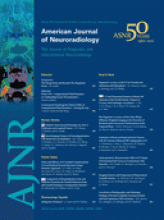Abstract
BACKGROUND AND PURPOSE: 4D-CT is a novel method of multiphase CT imaging. When used to localize parathyroid adenomas and hyperplasia, this technique may allow for more robust diagnostic accuracy than traditional sonography and nuclear scintigraphy techniques. The purpose of our study is to assess the accuracy of 4D-CT for localizing pathologically proved parathyroid adenomas and hyperplasia found during surgery.
MATERIALS AND METHODS: A total of 35 pathologically proved cases of parathyroid adenoma and hyperplasia were retrospectively reviewed between January 2009 and March 2011. Inclusion criteria were availability of final surgical pathology and performance of preoperative 4D-CT. No cases were excluded. Sensitivity, specificity, and accuracy of 4D-CT were ascertained including both the side and quadrant of the pathologically proved lesion.
RESULTS: Of the 35 pathologically proved cases collected over the study period, 32 (sensitivity = 91%) patients were found positive for parathyroid disease using 4D-CT, including 3 cases of multigland disease. For lateralization of single-gland disease, 4D-CT demonstrated an accuracy of 93%. 4D-CT revealed a suboptimal 44% sensitivity, but 100% specificity, for multigland disease.
CONCLUSIONS: 4D-CT demonstrated a high diagnostic accuracy for single and multigland disease in our cohort. Importantly, 4D-CT accurately lateralized single-gland adenomas in >90% of cases, allowing the surgeon to employ a directed operative approach. 4D-CT also showed a very high specificity for the detection of multigland disease.
ABBREVIATIONS:
- CTDI
- CT dose index
- NPV
- negative predictive value
- PPV
- positive predictive value
- PTH
- parathyroid hormone
- © 2012 by American Journal of Neuroradiology












